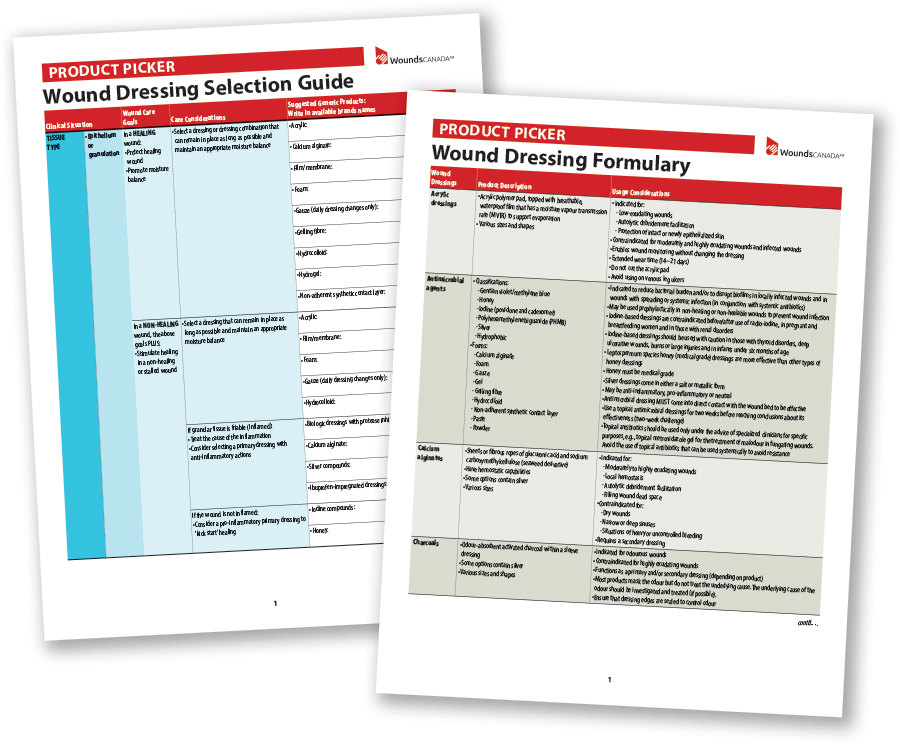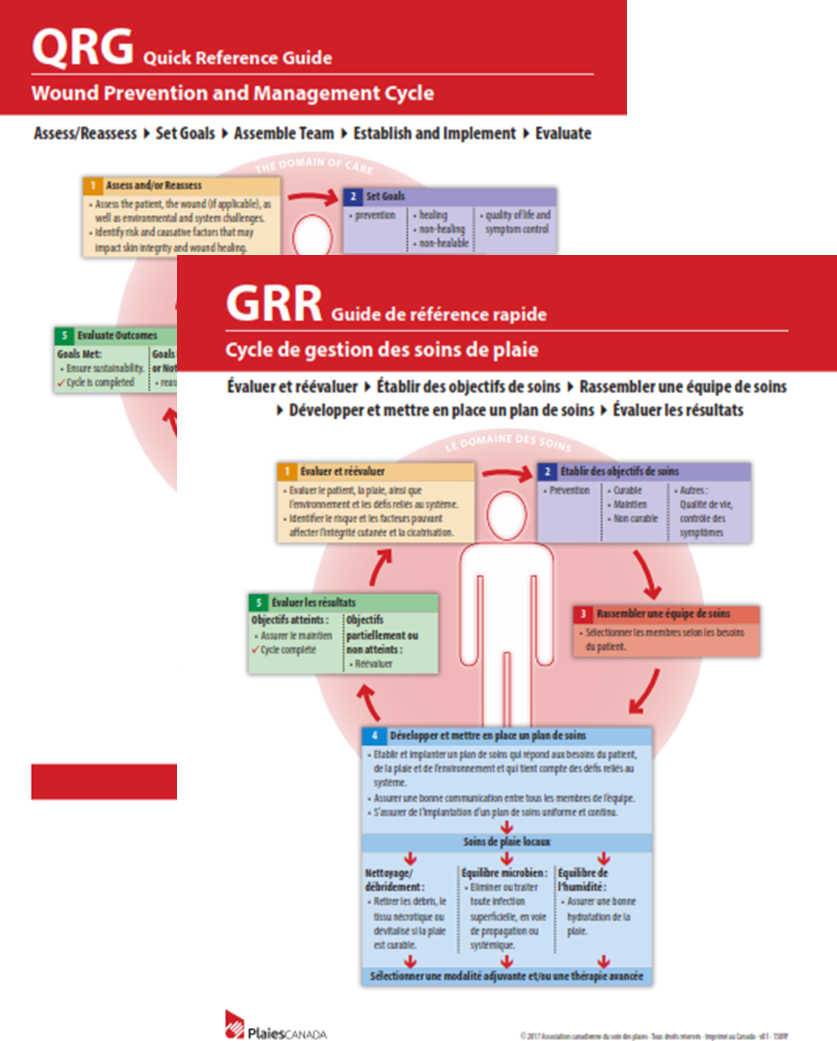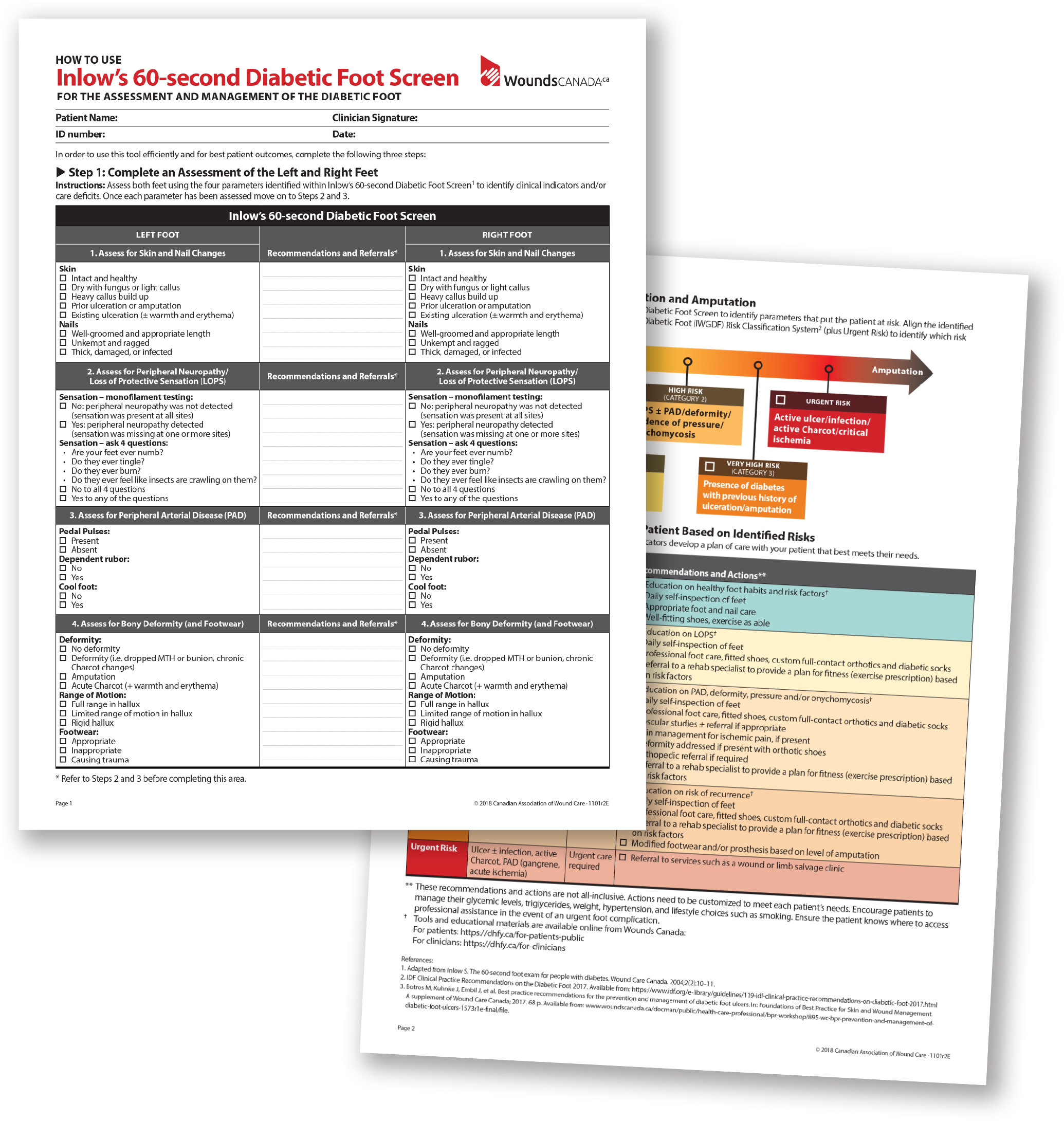Resources
Wounds Canada aims to provide the most up-to-date, evidence-based information available to health decision makers across Canada and around the world. We publish two major wound-related publications – Wound Care Canada and Diabetic Foot Canada e-Journal – and have created a reading list of interest of articles written by leading wound-care and policy experts, and information and tools to assist you in preventing and managing various types of wounds.
Wound Care Instrument
What is the Wound CARE Instrument?
The Wound Care Instrument was developed by Wounds Canada and the Canadian Association for Enterostomal Therapy to provide a set of standards that support healthcare providers, wound management leaders, educators, purchasing managers, administrators, organizations, and health authorities to undertake a comprehensive and collaborative evidence-informed appraisal process before developing or introducing a wound management educational event or program.
The Wound CARE Instrument will:
Provide a foundation to identify the components required to plan, develop, implement, evaluate and sustain evidence-informed wound management education and programming.
Provide a benchmark to appraise the quality of wound management education and programming.
Support collaboration in the development and implementation of wound management education and programming.
Inform decisions related to the endorsement, adoption, adaption, purchase or rejection of wound management education and programming.
Improve patient care and health outcomes relating to the prevention and management.
Why Use the Wound CARE Instrument?
With the latest evidence on education and program development synthesized into one document, healthcare professionals and organizations can standardize and improve the quality of wound care; thus, valuable resources may be reallocated to support other healthcare outcomes.
These standards for wound care education and program development can greatly affect the delivery and outcomes of wound management, making a significant contribution to Canadian healthcare.
The Wound CARE Instrument is divided into five phases that successfully support education and program development. Each phase in the Wound CARE Instrument has identified standards, which are followed by a discussion of the evidence.
Phase 1:
Preliminary Planning is an often forgotten step that ensures the purpose and goal are considered beforehand. This activity must be completed in a collaborative, comprehensive manner to successfully accomplish the remaining phases.
Phase 2:
Preparation and Development ensure that the components of the design and planning of the wound management educational event or program are met.
Phase 3:
Implementation supports the effective delivery of wound management educational events and programs.
Phase 4:
Outcomes provide the elements necessary to evaluate and measure the results post-implementation of wound management educational events and programs.
Phase 5:
Sustainability and Post- Implementation Planning ensure that short- and long-term strategies are in place to maintain the benefits of the wound management educational event or program, and provide ongoing support and evaluation.
How to use the Wound CARE Instrument:
Step 1: Select an educational event or program to be appraised and identify stakeholders to be involved in the decision-making.
Step 2: Stakeholders must review the proposed or existing educational event or program, consider preliminary planning, planning and development, implementation, evaluation and sustainability.
Step 3: Each stakeholder appraises and scores* the event or program independently, using the standards identified in the Wound CARE Instrument.
Step 4: Stakeholders meet to discuss their independent reviews and arrive collaboratively at a decision. They achieve consensus to endorse, adopt, adapt, purchase or reject the educational event or program.
Step 5: The instrument is signed by each stakeholder and dated to document the appraisal and final recommendation. This record should be kept on file.
* By using a scoring system the stakeholders can identify the weak areas easily and recommend improvement to increase the quality of the educational event or program.
Development Team
• Heather Orsted, RN, BN, ET, MSc
• Kimberly Stevenson, RN, BN, IIWCC
• M. Gail Woodbury, BScPT, MSc, PhD
Task Force
• Heather Orsted, RN, BN, ET, MSc (Chair)
• Karen Bruton, RN, CETN(C), IIWCC
• Patricia Coutts, RN, IIWCC
• Catherine Harley, RN, IIWCC, EMBA
• Mary Hill, RN, BScN, CETN(C), MScN
• David Keast, MSc, MD, FCFP
• Kathryn Kozell, RN, BA, MScN,CETN(C),APN (AC)
• Kimberly LeBlanc, BScN, RN,CETN(C),MN, IIWCC,
• R. Gary Sibbald, BSc, MD, FRCPC(Med) (Derm)
• Kevin Woo, RN, MSc, PhD, ACNP, GNC(C)
The Wound CARE Instrument has undergone a Delphi panel of Canadian wound care educators and a pilot with Canadian wound care clinicians and relevant stakeholders.
The Wound CARE Instrument is now available for distribution and downloading. Please CLICK HERE to download the Wound CARE Instrument in PDF.
National and International Wound Care Events
You will find below a listing of National and International wound care related events.
International Interprofessional Wound Care Course
Providence Health Care - Hacking Wounds
Symposium on Hidradenitis Suppurativa Advances
Skin and Wound Healing Week
Library
En francais? Cliquez ici
As part of our efforts to support professional education, Wounds Canada is pleased to provide links to resources on all aspects of wound management and prevention. In this section you will find a comprehensive wound care resource library. Wounds Canada is dedicated to a collaborative, integrated team approach to wound management and prevention. We believe that our efforts to enhance health professionals’ knowledge, skills and abilities will ultimately improve the health of Canadians as well as lead to improvements in our publicly funded healthcare system.

New:
Updated Inlow Foot Screening Tool: click here
Updated Product Pickers: click here
A number of the documents in this area are in PDF format. If you do not have Adobe Acrobat Reader, you can download it from Adobe.
Document Categories
Clinical Practice
- 2017 Series of Best Practice Guidelines
-
Best Practice Recommendations for the Prevention and Treatment of Venous Leg Ulcers: Update 2006
Brian Kunimoto, Maureen Cooling, Wayne Gulliver, Pamela E. Houghton, Heather L. Orsted, and R. Gary Sibbald - Best Practice Recommendations for Preparing the Wound Bed: Update 2006
R. Gary Sibbald, Heather L. Orsted, Patricia M. Coutts, David H. Keast
- Barriers to the implementation of best practice in wound care by Madeleine Flanagan
Education
-
First Nations Diabetic Foot Workshop
Heather L. Orsted -
Wound Care Education in Canada
David H. Keast -
A New Master’s Program in Wound Healing: Preparing Clinician Scientists to Advance Research and Practice
Pamela E. Houghton
Public Policy
- Wound Care Instrument
- Assessing and Developing Clinical Practice Guidelines
Cathy Burrows, Heather Orsted, Laura Teague, Rob Miller, Christine Peason, Sharon Evashkevich, Wendy Marr, Delilah Guy, Wayne Gulliver - Canadian Provincial Wound-Care Reimbursement: Focus on Alberta
- A Model for Implementing Best Practices in Wound Care in a Hospital Setting
Morty Eisenberg
Research
-
Prevalence of pressure ulcers in Canadian health-care settings. Woodbury MG, Houghton PE.
Ostomy/Wound Management. 2004;50(10):22-38.
Other Printable Resources
- Updated Product Pickers: click here
- Wound Management Cycle (quick reference guide) in PDF or for an image format: click here
- Le Cycle de gestion des soins de plaie (guide de reference rapide) version PDF ou en format JPEG, cliquez ici
- PEP Talk Daily Commitment Reference Card ENG
- PEP Talk Daily Commitment Reference Card FRN
- Facts on peripheral arterial disease (PAD) for patients
- Facts on peripheral arterial disease (PAD) for physicians
- Faits sur la maladie artérielle périphérique (MAP) pour patients
- Faits sur la maladie artérielle périphérique (MAP) pour doctors
Diabetes, Healthy Feet and You: tools and brochures. To access documentation for your patients, click here.
- Diabetes, Healthy Feet and You: Poster for clinician
- Diabetes, Healthy Feet and You: Poster for clinician (French)
- Diabetes, Healthy Feet and Your Patient: Brochure for clinician
- Diabetes, Healthy Feet and You: Patient Brochure
Resources Available in French
Dans nos efforts d’appuyer l'éducation professionnelle, Plaies Canada est heureuse de fournir des ressources sur la gestion et de la prévention des plaies. Ci-dessous, vous trouverez nos ressources disponibles en français. Nous espérons d’ajouter plus de ressources à cette section à mesure qu'elles seront disponibles.
- Pratiques exemplaires --> La peau: anatomie, physiologie et cicatrisation des plaies
- Pratiques exemplaires --> La Prévention et la Gestion des Plaies
- Pratiques exemplaires --> La prévention et la gestion des lésions de pression
- Le Cycle de gestion des soins de plaie (guide de reference rapide)
- Clinique au Québec: Clinique des plaies complexes
- Le choix d'un produit: Product Picker Dressing Selection Guide
- Faits sur la maladie artérielle périphérique (MAP) pour patients
- Faits sur la maladie artérielle périphérique (MAP) pour docteurs
- Le diabète et le soin des pieds
- Dépistage de pied diabétique en 60 secondes: cliquer ici
-
Mon engagement quotidien (pour le patient):
PEP Talk Daily Commitment Reference Card FRN - La difformité du pied (pour le patient): cliquer ici
- L’insuffisance vasculaire (pour le patient): cliquer ici
- Diabetes, Healthy Feet and You: Brochure/poster for clinician (French)

